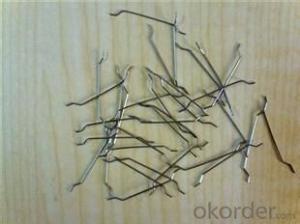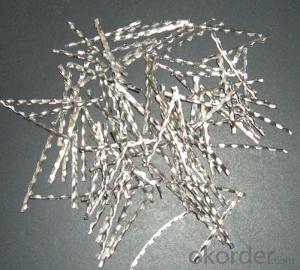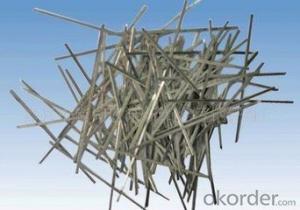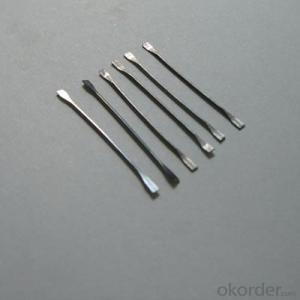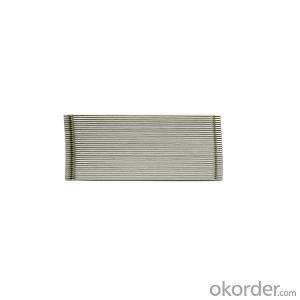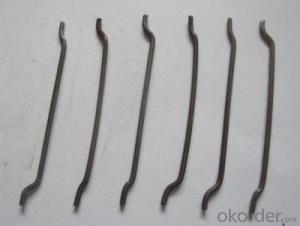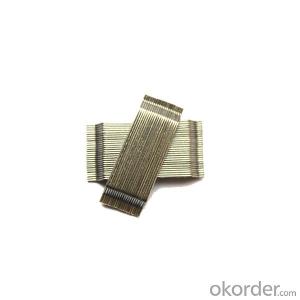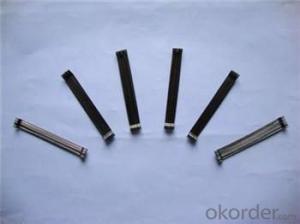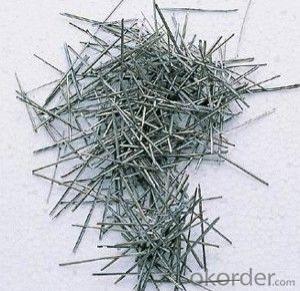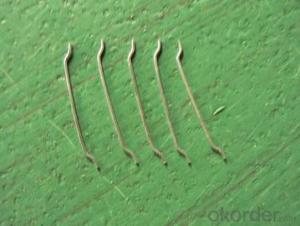Steel Fiber Copper Coated Company From CNBM
- Loading Port:
- Tianjin
- Payment Terms:
- TT OR LC
- Min Order Qty:
- 2000 kg
- Supply Capability:
- 30000 kg/month
OKorder Service Pledge
OKorder Financial Service
You Might Also Like
Quick Details
Place of Origin: Jiangsu, China (Mainland)
Model Number: HT-ST
Material: Steel
Specifications
ISO 9001 certificated
2.70% for Europe, Middle Asia, America market
3.Have the most number of steel fiber machine in china
1. Material: low carbon steel wire or stainless steel
2.Diameter: 0.4mm-1.0mm
3.Length: meet your requirements
4.tensile strength >1000Mpa
6.Feature: excellent tensile,high tenacity,against cracking,impact and fatigue
7.Uses: highway road surface,tunnel,building,airport road surface and so on .
Straight Steel Fiber
1.ISO 9001 certificated
2.70% for Europe, Middle Asia, America market
3.Have the most number of steel fiber machine in china
Picture
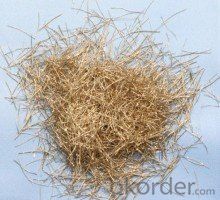
Steel fiber
FAQ
certificated: ISO 9001
Technical advantages of Daye steel fiber:
A. Improve mechanical performance of concrete
B. Provide uniform distribution throughout concrete with excellent mixing
C. No balling or caking by adopt correct mixing method
D. Reduce concrete volume
E.Save construction time and cost
F.Reduce excavation volume
G.Available for jointless floor.
- Q:Can melt extract stainless steel fiber improve the resistance of concrete to impact loads?
- Indeed, the utilization of melt extract stainless steel fiber has the potential to enhance the resistance of concrete to impact loads. Stainless steel fibers are renowned for their robust tensile strength, durability, and ability to augment the mechanical properties of concrete. Incorporating stainless steel fibers into concrete mixtures aids in the even distribution of applied loads and impedes crack propagation, thereby fortifying the concrete's resistance to impact loads. These fibers function as reinforcement within the concrete matrix, effectively bolstering its impact resistance and overall toughness. Moreover, melt extract stainless steel fibers possess a high melting point, enabling them to retain their structural integrity even in extreme temperatures or rapid heating scenarios. This characteristic further contributes to the heightened impact resistance of concrete. Ultimately, the inclusion of melt extract stainless steel fibers can significantly elevate the concrete's capacity to withstand impact loads and optimize its performance in applications where impact resistance is paramount, such as industrial floors, pavements, and heavily trafficked areas.
- Q:How does melt extract stainless steel fiber improve the impact resistance of industrial flooring?
- Melt extract stainless steel fiber is known for its ability to enhance the impact resistance of industrial flooring significantly. This improvement is primarily attributed to the unique characteristics of stainless steel fibers. Firstly, melt extract stainless steel fibers are exceptionally strong and durable. They are manufactured using a specialized process that ensures they possess high tensile strength and can withstand heavy loads and impact forces. When these fibers are added to the concrete mix used for industrial flooring, they act as reinforcement, effectively reinforcing the structure and making it more resistant to impact. Additionally, the presence of stainless steel fibers in the concrete matrix helps to distribute and dissipate the energy generated from impacts. When an object strikes the flooring, the fibers act as a network of tiny reinforcements that absorb and disperse the energy throughout the entire concrete slab. This distributes the impact forces, preventing concentrated damage and reducing the risk of cracks or fractures. Moreover, the unique properties of stainless steel, such as its corrosion resistance, ensure that the fibers maintain their structural integrity over time. This means that even after prolonged exposure to harsh industrial environments, the stainless steel fibers will remain effective in enhancing impact resistance. Furthermore, the addition of melt extract stainless steel fibers improves the overall toughness and ductility of the flooring. This means that the concrete will exhibit enhanced flexural strength and resistance to deformation. As a result, the flooring will be able to withstand heavy impacts without breaking or becoming permanently damaged. In conclusion, melt extract stainless steel fiber improves the impact resistance of industrial flooring by providing additional reinforcement, distributing impact forces, maintaining structural integrity, and enhancing toughness and ductility. These characteristics make it an excellent choice for industries where impact resistance is crucial, such as warehouses, factories, and manufacturing facilities.
- Q:What is the effect of melt extract stainless steel fiber on the carbonation resistance of concrete?
- The melt extract stainless steel fiber has a positive effect on the carbonation resistance of concrete. It helps to improve the durability and longevity of concrete structures by reducing the rate at which carbon dioxide can penetrate into the concrete and react with the alkaline components, thereby reducing the risk of carbonation-induced corrosion.
- Q:How does melt extract stainless steel fiber affect the permeability of concrete?
- The permeability of concrete is significantly affected by the inclusion of melt extract stainless steel fibers. These fibers, which are slender and elongated strands, are incorporated into concrete mixtures during the mixing process. Once evenly distributed throughout the concrete, they form a three-dimensional network that enhances the overall strength and durability of the material. One of the primary advantages of using stainless steel fibers is the reduction in concrete permeability. Concrete is naturally a porous substance, allowing the passage of liquids and gases. However, the addition of stainless steel fibers helps to seal these pores and decrease the permeability of the concrete. The melt extract stainless steel fibers serve as a physical barrier, preventing the infiltration of water, chemicals, and other harmful substances into the concrete. This is particularly crucial in environments where the concrete is exposed to harsh conditions, such as marine or industrial settings. By reducing the permeability of concrete, the inclusion of stainless steel fibers also enhances its resistance to corrosion and deterioration. These fibers help to limit the penetration of moisture and aggressive agents that can cause the reinforcement steel within the concrete to rust. Consequently, the lifespan of the concrete structure is prolonged, and maintenance expenses are minimized. Moreover, the decreased permeability of concrete with stainless steel fibers also improves its ability to withstand freeze-thaw cycles. When water enters the concrete and freezes, it expands, generating internal pressure and leading to cracks and deterioration. The presence of stainless steel fibers restricts the entry of water, thus reducing the potential for freeze-thaw damage. In conclusion, melt extract stainless steel fibers have a positive impact on the permeability of concrete. They diminish the flow of water and other harmful substances, improving the durability, resistance to corrosion, and ability to withstand freeze-thaw cycles of the concrete. By enhancing these properties, stainless steel fibers contribute to the overall performance and longevity of concrete structures.
- Q:How is melt extract stainless steel fiber produced?
- Melt extract stainless steel fiber is produced through a specialized manufacturing process. The first step involves melting high-quality stainless steel alloy in a furnace at extremely high temperatures. The molten steel is then forced through a spinneret, which is a fine nozzle with multiple small holes. As the molten steel is extruded through these holes, it solidifies and forms thin fibers. Once the fibers are formed, they are rapidly cooled and solidified by passing them through a cooling chamber or a quench bath. This process ensures that the fibers maintain their desired shape and strength. After cooling, the fibers are collected and further processed to remove any impurities or contaminants. The collected stainless steel fibers are typically cut into shorter lengths to enhance their usability in various applications. They can be further processed to modify their surface properties, such as by coating them with a protective layer or applying different surface treatments. The melt extract process allows for the production of stainless steel fibers with consistent dimensions and properties. These fibers possess excellent tensile strength, corrosion resistance, and high thermal conductivity, making them suitable for a wide range of applications. They are commonly used in concrete reinforcement, refractories, filtration systems, and as conductive additives in various industries.
- Q:How does melt extract stainless steel fiber contribute to the fatigue behavior of concrete?
- The fatigue behavior of concrete is significantly improved by the presence of melt extract stainless steel fiber. These fibers enhance the resistance to cracking and increase the durability of the concrete, especially under cyclic loading conditions. The reduction of microcrack propagation is one of the main ways in which melt extract stainless steel fiber contributes to the fatigue behavior of concrete. When concrete undergoes repeated loading and unloading cycles, microcracks start to form and spread, ultimately resulting in failure. However, the stainless steel fibers act as reinforcement, effectively bridging these microcracks and preventing their further propagation. This enhances the overall fatigue resistance of the concrete and extends its lifespan. Furthermore, melt extract stainless steel fibers also improve the tensile strength and ductility of concrete. Concrete is known for its low tensile strength, but the inclusion of fibers helps to overcome this weakness. The fibers evenly distribute the applied load throughout the concrete matrix, reducing stress concentrations and enhancing its ability to withstand cyclic loading. This ultimately leads to improved fatigue behavior. Moreover, the use of melt extract stainless steel fibers in concrete can enhance its resistance to corrosion. Stainless steel inherently has resistance to corrosion, and when incorporated into the concrete mix, it acts as a protective barrier against aggressive substances like chlorides and sulfates. This prevents corrosion of the reinforcing steel within the concrete, which can weaken its structural integrity and cause premature failure. In conclusion, melt extract stainless steel fiber greatly enhances the fatigue behavior of concrete by reducing microcrack propagation, increasing tensile strength and ductility, and improving resistance to corrosion. These benefits enhance the durability and lifespan of concrete structures, making them more reliable and cost-effective in the long term.
- Q:Steel fiber concrete structure and steel reinforced concrete structure belong to concrete mix structure?
- Steel fiber reinforced concrete is a new kind of multiphase composite material, which is made up of short steel fiber reinforced by random distribution in ordinary concrete.SRC structure according to the code for design of SRC structures (YB9082-97), the steel content is greater than 2%, less than 15%.SRC structure still belongs to the category of reinforced concrete structure.Steel fiber reinforced concrete structure is still a kind of masonry structure.
- Q:How does melt extract stainless steel fiber improve the bond strength of shotcrete?
- Shotcrete bond strength is improved in multiple ways by melt extract stainless steel fiber. Firstly, the reinforcement provided by the steel fibers within the shotcrete mix increases the material's strength. The fibers are evenly distributed throughout the mix when applied, creating a reinforcement network that enhances overall bond strength. Secondly, the high aspect ratio of the stainless steel fibers, characterized by their length and thinness, allows them to effectively bridge any cracks or voids that may form within the shotcrete. By bridging these gaps, the fibers prevent crack propagation and enhance material cohesion, thereby increasing bond strength. Moreover, the stainless steel fibers also enhance shotcrete durability. With corrosion resistance properties, they can withstand harsh environments and prevent degradation over time. This durability ensures that the bond strength of the shotcrete remains intact for an extended period, even under challenging conditions. In conclusion, melt extract stainless steel fiber improves shotcrete bond strength through reinforcement, crack bridging, and increased durability. This makes shotcrete more reliable and effective for various construction applications, including tunnel linings, retaining walls, and structural repairs.
- Q:Can melt extract stainless steel fiber be used in concrete pavement overlays?
- Yes, melt extract stainless steel fiber can be used in concrete pavement overlays.
- Q:How does melt extract stainless steel fiber improve the fire resistance of concrete?
- The fire resistance of concrete is improved by the presence of melt extract stainless steel fiber, which serves as a reinforcement material. When exposed to high temperatures during a fire, the stainless steel fiber reinforces the concrete, enhancing its structural integrity by providing extra strength and stability. The stainless steel fiber is capable of withstanding high temperatures without melting or losing its mechanical properties. As a result, it effectively distributes stress and load within the concrete, preventing cracks and fractures that could compromise the material's structural integrity. Moreover, the stainless steel fiber in the concrete helps delay the occurrence of spalling. Spalling is when the surface layers of concrete break apart and detach due to the rapid expansion of trapped moisture within the material when exposed to high temperatures. By reinforcing the concrete, the stainless steel fiber retains moisture and hinders its rapid release, thereby reducing the risk of spalling. Additionally, the stainless steel fiber acts as a heat sink, absorbing and dissipating heat more efficiently than the surrounding concrete. This capability aids in reducing the overall temperature increase of the material during a fire. By diminishing the temperature rise, the stainless steel fiber can minimize thermal expansion and contraction, decreasing the chances of cracks and preserving the concrete's structural integrity. In conclusion, incorporating melt extract stainless steel fiber into concrete greatly enhances its fire resistance by bolstering its structural strength, reducing spalling, and minimizing temperature rise. This makes it a highly effective solution for enhancing the fire safety of concrete structures in various applications, such as buildings, tunnels, and industrial facilities.
1. Manufacturer Overview |
|
|---|---|
| Location | |
| Year Established | |
| Annual Output Value | |
| Main Markets | |
| Company Certifications | |
2. Manufacturer Certificates |
|
|---|---|
| a) Certification Name | |
| Range | |
| Reference | |
| Validity Period | |
3. Manufacturer Capability |
|
|---|---|
| a)Trade Capacity | |
| Nearest Port | |
| Export Percentage | |
| No.of Employees in Trade Department | |
| Language Spoken: | |
| b)Factory Information | |
| Factory Size: | |
| No. of Production Lines | |
| Contract Manufacturing | |
| Product Price Range | |
Send your message to us
Steel Fiber Copper Coated Company From CNBM
- Loading Port:
- Tianjin
- Payment Terms:
- TT OR LC
- Min Order Qty:
- 2000 kg
- Supply Capability:
- 30000 kg/month
OKorder Service Pledge
OKorder Financial Service
Similar products
New products
Hot products
Hot Searches
Related keywords

